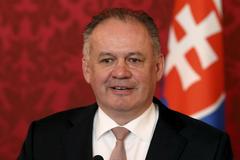Neither the name, nor the agenda of the emerging political party of Andrej Kiska, whose presidential term ends this week, are known to the public yet. Voters have learnt a few names last week – Juraj Šeliga, co-founder of For a Decent Slovakia, Miroslav Kollár, mayor of Hlohovec, and Vladimír Ledecký, mayor of Spišský Hrhov.
Even so, the new political party of the current president would attract voters from all existing parliamentary parties, according to a recent AKO poll. The poll was conducted for the Hospodárske Noviny daily between May 28 and 31 on 1,000 respondents.
Luring PS/Spolu and SaS voters

The poll measured 10.8 percent support for Kiska’s party as the fourth strongest party on the scene.
Smer leads the poll with 17.4 percent, followed by the coalition of Progressive Slovakia and Spolu (PS/Spolu) with 15.6 percent and People’s Party - Our Slovakia (ĽSNS).
Freedom and Solidarity (SaS) came in fifth, after Kiska’s party. This party lost 2 percentage points and together with PS/Spolu, down by 2.4 percentage points, they are the parties that would lose the most.
Across the political spectre
The far right ĽSNS would have 13.8 percent without Kiska’s party, but one percentage point less with the party. Christian Democratic Movement (KDH) would only lose a small amount of voters with Kiska’s party, down from 8.6 percent to 8.1 percent. Junior coalition Slovak National Party (SNS) would drop from 7.2 percent to 6.4 percent.
Kiska's party is a threat to Ordinary People and Independent Personalities (OĽaNO), down from 6.3 percent (without Kiska’s party) to 5.7 percent with Kiska’s party. Parties need to garner at least 5 percent to get parliamentary seats.
“The interesting thing is that potential voters could be found across the spectre of political parties, less so in Smer or ĽSNS, but the party can steal also from these parties too,” Václav Hřích, director of AKO polling agency, told The Slovak Spectator. “Every party has supporters who trust Andrej Kiska.”



 Andrej Kiska (source: SITA)
Andrej Kiska (source: SITA)